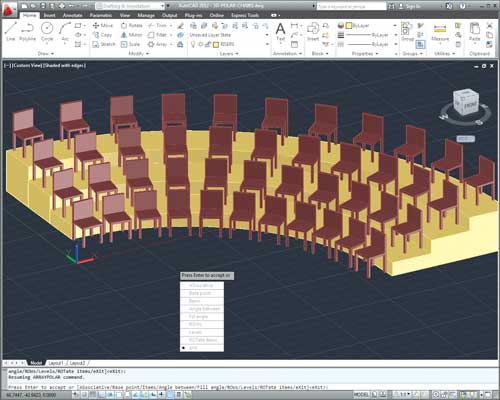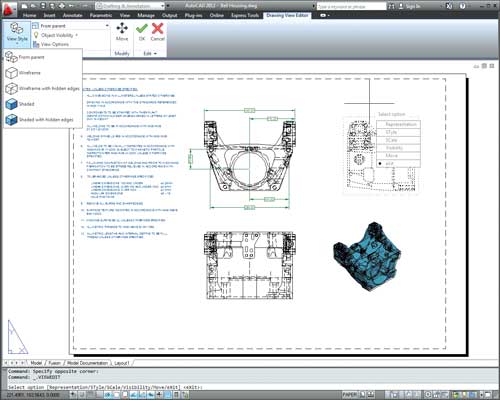+
AutoCAD 2012.
In the past, that might have meant a release relatively light on new features, much as AutoCAD 2009 offered few surprises beyond the now-familiar ribbon interface. But while really big enhancements may have to wait until next year, AutoCAD 2012 provides a wealth of welcome changes.
Borrowing from the MacLast fall, Autodesk quelled rumors when it released the first native Macintosh version of AutoCAD in nearly 20 years (see deskeng.com/articles/aabamx.htm). In addition to a totally Mac interface, AutoCAD 2011 for the Mac featured new in-canvas viewport controls. These same tools have now been added to AutoCAD 2012, enabling users to change viewport settings, views and visual styles by using tools that always appear in the upper-left corner of each viewport.
In-canvas control is further exploited in AutoCAD 2012 by the addition of new user coordinate system (UCS) icon functions. The UCS icon can now be selected and manipulated by using grips to quickly align the UCS with existing objects, including curved surfaces and solids. You can also right-click on the UCS icon to access additional UCS controls from a new shortcut menu, making it much easier to manipulate the coordinate system "particularly when working in three-dimensional space.
There are actually all sorts of subtle 3D changes. For example, a new Offset Edge tool lets you create an offset curve from a planar 3D face or surface. You can then use the Presspull tool to quickly add or remove the bounded area from a solid, and Presspull now repeats until you exit the command. In addition, when creating or modifying surfaces or solids, the software displays a preview of the resulting model, and how it will change before you commit to the change. So now, when you select a profile to create a lofted solid or surface, for example, an updated preview of the resulting object is displayed with each selection.

You can now create associative rectangular, polar or path arrays in 2D
or 3D, change the number of objects or array relationships, and even
replace arrayed objects.
The new preview also works when filleting, chamfering, blending or patching surfaces and solids, and there are new chain and loop selection options when modifying 3D models. The preview works when creating 2D fillets and chamfers, as well.
Another interface change is the new auto-complete function. In spite of improvements to its ribbon interface, many longtime AutoCAD users simply type to start commands. But as the software has evolved over more than 25 years, the number of commands and system variables has grown, making it difficult to remember them all. With auto-complete, as you type at the program’s command prompt or dynamic input field, AutoCAD 2012 displays a list of commands matching what you’ve typed thus far. You can then quickly select the command or system variable from the list.
Creating Associative ArraysOne particular addition to AutoCAD 2012 stands out as one of the biggest productivity improvement in years: AutoCAD can now create associative arrays.
Rather than simply making duplicate copies of selected objects, arranged in a rectangular or circular pattern, the old Array tool in AutoCAD has been replaced by three new commands for creating rectangular arrays, polar arrays or evenly distributing objects along a path formed by objects such as lines, arcs, polylines or helixes. Once the objects are positioned, you can modify them by changing the array relationships, such as increasing the number of rows or columns, changing the distance or angle between the copies, or modifying the individual items in the array. You can even change the source object and apply the changes to the rest of the items in the array.
The new array functionality isn’t limited to 2D, however. All three types of arrays can include multiple levels, and path arrays can follow 3D paths. Nor are associative arrays the only big 2D improvement. Multi-functional grips have been extended to more AutoCAD objects, such as lines, arcs and dimensions, as well as 3D faces, edges and vertices. When you hover the cursor over a grip, you now see a list of available options "and with dynamic input enabled, you can enter dimensional values.
AutoCAD 2012 also includes improved tangent and perpendicular object snap functionality. When grip editing, AutoCAD now finds osnap points to make objects tangent or perpendicular, and if AutoCAD’s inferred constraint function is toggled on, a corresponding geometric constraint is automatically applied.
There’s also a new array option when using the Copy tool to make multiple separate copies of objects at once, and AutoCAD can now create a fillet between splines. In fact, there are a number of enhancements to splines. For example, a new Blend tool creates a spline object between lines, arcs, polylines, splines and helixes, and includes an option to control the continuity between the two curves "very important if the resulting curve will be used as the basis for a 3D surface.

The new drawing views capability lets you quickly create orthographic
and projected views of 3D models, and control their view style and scale.
Manipulating 3D ModelsAutoCAD 2012 represents some significant changes in the way users interact with three-dimensional models. In past releases, AutoCAD remembered the operations performed on solid objects. But in AutoCAD 2012, Solid History is toggled off by default. That means that users can no longer press the CTRL key to select and modify the properties of sub-objects that had been combined to form more complex solids. While users can certainly turn Solid History back on before creating 3D models, Autodesk’s intention is to move customers toward direct manipulation of non-history-based solids.
To accomplish that, AutoCAD 2012 automatically installs Autodesk Inventor Fusion, a plug-in that lets you edit 3D models using intuitive direct manipulation. When working on a 3D model, a single click opens the current drawing in Fusion. There’s no need to save and export the file. Once in Fusion, you can edit faces, edges and vertices, modify sub-objects, and add new features. After making the desired changes, a single click returns the updated model directly to AutoCAD "again without having to first save any files.
 |
| Download Setup file only |
 |
| Download Crack and serial only |










worst service u have
ReplyDeleteHi” i think that you should add captcha to your blog” read the article
ReplyDeletePretty nice post. I just stumbled upon your weblog and wanted to say that I have really enjoyed browsing your blog posts. After all I’ll be subscribing to your feed and I hope you write again soon! free cad
ReplyDeletePretty good post. I just stumbled upon your blog and wanted to say that I have really enjoyed reading your blog posts. Any way I'll be subscribing to your feed and I hope you post again soon. Big thanks for the useful info. m4a download
ReplyDeleteThanks for writing such a good article, I stumbled onto your blog and read a few post. I like your style of writing... stream torrent videos
ReplyDelete